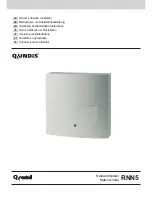
PRODUCT OVERVIEW
001-9193-001 Version 1
Page 10 of 48
Sentry 4G 900
TM
User Manual
2.6
Antenna Options
Antennas are available for Sentry 4G routers installations from CalAmp Corp.
2.6.1
Transmit/Receive Antennas (TRX)
The primary antenna connections on the Sentry 4G unit are TNC female connectors; therefore
you must purchase antennas with TNC male connectors. Do not select TNC antennas with
“reverse polarity” or RP-Male. Mounting options and cable lengths are the user’s choice and
application specific.
Caution:
This device has been designed to operate with the antenna described below, and having a
maximum gain of 7.15 dBi. Other antennas or having a gain greater than 7.15 dBi are
strictly prohibited for use with this device. The required antenna impedance is 50Ω.
Recommended antenna: MAXRAD model MAX9105
It is highly recommended to have the antenna installation performed by a professional.
2.6.2
GPS Antenna
The Sentry 4G router’s GPS connector requires an external 3.3V GPS antenna. The GPS antenna
connection on the Sentry 4G product is a female SMA connector; therefore an antenna with an
SMA male connector is required. For best coverage, use an active antenna with a gain between
10 and 30 dB. Mounting options and cable lengths are user’s choice and application specific.
2.6.3
WiFi Antenna
The WiFi antenna connections on the Sentry 4G product are RP-SMA jacks; therefore antennas
with an RP-SMA plug are required. Mounting options and cable lengths are user’s choice and
application specific.
Industry Canada RSS Notices:
This device has been designed to operate with the antennas listed below, and having a
maximum gain of 5.5 dBi. Antennas not included in this list or having a gain greater than 5.5
dBi are strictly prohibited for use with this device. The required antenna impedance is 50Ω.
Manufacturer
Model Number
Antenna Type
Gain
RadioLabs Inc
2.4-mobile3
Mag Mount
5.5 dBi
To reduce potential radio interference to other users, the antenna type and its gain should be
so chosen that the equivalent isotropically radiated power (EIRP) is not more than that
permitted for successful communication.
2.6.4
Antenna Spacing
Referring to Figure 3 for illustration, Sentry 4G unit commonly uses four separate antennas:
“T” - Main transceiver -
Constraints are the limit of 20 cm and omni-directional factors
“A” - Auxiliary transceiver –
Constraints are the receiver spacing of at least 5/8 (wavelength) from transceiver antenna and
omni-directional requirements
“G” - Global Positioning System (GPS)











































